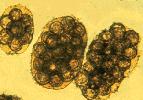Cyclophyllidea Life-Cycle
| This article is still under construction. |
Overview
Cyclophyllidae cestodes have an indirect life cycle involving one or more intermediate hosts before developing into adult form in the definitive host. Eggs must be ingested by an intermediate host species, once ingested the gastric and intestinal secretions breakdown the thick shell and activate the 6-hooked oncosphere. The oncosphere uses its hooks to tear through the gastrointestinal mucosa to reach the blood or lymph system. In invertebrate hosts the oncosphere will enter directly into the body cavity from the gastrointestinal tract. The oncosphere then travels to its predeliction site, loses its hooks and develops into the larval stage known as a metacestode. This can be one of a number of forms dependant on the species of cestode.
Metacestodes
There are six types of metacestode (in increasing order of complexity:
Cysticercus
This is a simple metacestode consisting of a fluid filled bladder containing a single inverted scolex.
Cysticercoid
This is a simple metacestode that is only found in invertebrates. It is small, pinhead sized, and instead of a bladder has a potential space containing a single scolex that is not inverted.
Strobilocercus
This metacestode is only formed by the cat tapeform Taenia taeniaeformis and is similar to a cysticercus however the single scolex is attached to the containing bladder by a chain of segments.
Coenurus
Similar in form to the cysticercus, however the coenurus contains multiple inverted scolices.
Hydatid cyst
5) Hydatid cyst: the metacestode of Echinococcus granulosus; this fluid-filled bladder can grow to the size of a football; it is lined with germinal epithelium that buds off brood capsules internally; inverted scolices form inside these; hydatid sand is the name given to the brood capsules and scolices in the hydatid fluid; the host attempts to wall off the hydatid cyst with fibrous tissue; between this and the germinal membrane is an amorphous layer
6) Alveolar cyst: the metacestode of Echinococcus multilocularis; this is like the hydatid cyst, but daughter cysts bud off the external, as well as the internal, surface of the germinal layer, with the result that the metacestode expands by infiltrating through the tissue, rather like a tumour.
When the metacestode is ingested by the final host, the scolex attaches to the mucosa, the remainder of the structure is digested, and a chain of proglottids (segments) begins to grow from the base of the scolex.
Infection of the final-host involves at least three epidemiological relationships:
1) predator-prey, e.g. cat eating infected mouse
2) accidental, e.g. horse eating infected pasture mites
3) irritation, e.g. infected flea on animal = exaggerated grooming of animal = swallowed
